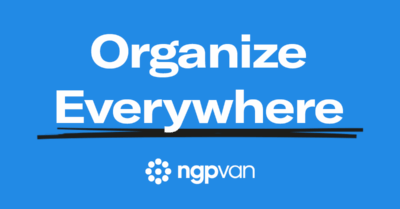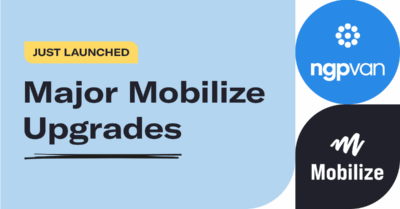Launch a Winning Campaign: 10 Political Campaign Strategies

Victories in the 2020 and 2022 elections have inspired Democratic and progressive candidates across the country to step up and run for office in their communities. Launching a campaign is exciting, but it also requires a well-thought-out plan.
Your launch day should be one of the biggest fundraising and outreach days of your campaign. To start strong and keep that momentum going, candidates should equip themselves with the best tools and strategies around.
Follow these ten steps to get your campaign ready for launch day and run a winning campaign.
1. Define Your “Why”
The number one question you will likely get asked on the campaign trail is, “Why are you running for office?”
While you likely have many reasons, your answer needs to be a concise elevator pitch. Answers that are short, snappy, and impactful are easy to repeat and can help you establish your brand in voters’ minds.
When defining your “why,” try answering these questions:
- Is there a local issue that you’re running to resolve?
- Are you running to bring more representation to your local government?
- Are you frustrated by the passage of conservative policies?
Consider both your personal reasons and what answers are likely to resonate with your base. For example, if the previous holder of the office you’re running for has low approval ratings, speaking to how you can bring change or better represent your community’s interests has the potential to win over frustrated voters.
Have your “why” ready before launch day so you can answer the public’s questions easily and have consistent framing for the rest of your campaign.
2. Determine Your Target Voters
Who is your campaign’s target audience? At first glance, the answer might be voters in your district. However, getting in touch with every eligible voter is rarely possible and may not be the most effective or efficient way to use your campaign’s limited resources.
Instead, consider your target audience by answering these questions:
How many votes do you need to win?
Use data from past campaigns to determine how many voters are in your district and what percentage of them are likely to vote in this election cycle. This will help you calculate your win number and decide which voters you need to focus on to win your election. Let’s say you expect 10,000 voters to vote in your election and there are only two candidates in your race, so you need 50% of the vote plus one (5,001 votes) to win. Now, we can figure out how to reach that win number.
Who is likely to vote for you?
Every campaign will have a unique path to identify how to hit their win number for a general election, but there will be a base of supporters that should vote for your campaign. For instance, in some states, voters are required to register their party affiliation while other states allow voters to vote in either party’s primary election. However, both registered party affiliation, past primary voting history, and partisanship scores can be good indicators of likely support for your campaign. You will want to segment these voters into your Get Out the Vote (GOTV) universe as you want to mobilize them to vote for your campaign. If that universe is 4,000 voters, you only need to win 1,001 votes from independent voters or voters who are registered with or likely to support another party. While you may want to add a cushion to contact more than those 1,001 voters to win, those voters are the base for your persuasion universe (the voters you need to convince to support your campaign).
Who is likely to vote at all?
Another factor to consider is whether someone is likely to vote at all. You can pull lists in VAN of voters based on their past voting history or use scores to determine who is likely to vote in the upcoming election. Again, your campaign should have a specific win number, and you’ll need to figure out how to achieve it. That path to victory may include encouraging voters who are unlikely to vote in the election to cast their ballots in support of your campaign. However, you’ll need to determine that based on your available resources.
Based on the path to hit your win number, you can frame your campaign messaging to sway or mobilize the voters you need to win. If you need to energize your base of likely and identified supporters to win, do that. If you need to convince more voters to support your campaign, shape your messaging around the issues that matter most to the community and start persuading voters to support your campaign.
Tip: Your win number should drive nearly all of the decisions you make on your campaign. It’s critical to calculate this number early to determine how many voters you need to win your election which will then help determine how much money you need to raise, how many doors you need to knock, how many mailers you need to send, and much more.
3. Build a Communications Plan
Once you’ve established why you’re running and which voters you need to target, it’s time to get your topline messaging and talking points in order. While you don’t need to have every element of your platform in place for launch day, your stance on major issues should be solid.
Meet with your core team and make sure everyone understands where you stand on yourcore issues and is prepared to think on their feet when it comes to answering questions. Get ahead of potential challenges and smear campaigns by creating a rapid-response plan with your team so that you’re prepared to shut down false narratives and deliver a focused, consistent message.
In terms of media outreach, write an op-ed announcing why you’re running and have your communications team work on getting placements in local newspapers or other local publications. This op-ed can be similar to your announcement speech but with a few tweaks for publication.
Additionally, your launch day, along with the days after, will be when you get the most free press (otherwise known as earned media), so be ready to maximize it. If a local news or radio station wants to interview you, make time for it, because that opportunity might not come up again. Have a press kit ready with a media advisory and background materials, including a short biography, list of accomplishments, and professional photos.
4. Have a Website
The phrase “if you’re not on the internet, you don’t exist” is truer than ever on a campaign’s launch day. A website allows voters and supporters to find more information about your campaign, accept online donations, recruit volunteers, control the narrative about your campaign, and much more.
Web design can be a lengthy and complicated process, but not every page needs to be finalized by launch day. On the first days of your campaign, a simple but engaging website with a short biography and summary of where you stand on important issues along with forms to sign up for your email list, volunteer for the campaign, and donate will work well enough while you build out more detailed pages.
The five important pages you will want to develop early for your website are:
- A homepage. Ensure this page makes a positive first impression with an appealing design and working links. Whether someone comes to your website to donate or learn more about your campaign, your website should be easy to navigate and encourage additional action.
- An “About” page. Include your headshot, photos of you interacting with your community, and a biography. In your biography, highlight your professional career, any community groups you’re involved in, and how your background impacts your “why.” After stating that connection, explain your “why” in detail. You should add options for people to take additional action, like filling out a volunteer form, signing up for your email list, or reading where you stand on the issues.
- An “Issues” page. Even with complex issues, explain your stances with plain language as straightforwardly as possible. Many candidates choose to summarize their stances in bullet points and then offer a longer explanation below or on a different page. You can also create a form for people to ask questions about specific issues that are important to them. On this page, you can add a call to action (CTA) to encourage people to help you spread the word by volunteering and linking out to your volunteer sign-up form!
- A “Take Action” page. Create a form people can fill out to express interest in volunteering for your campaign. Typically, this form lists volunteering options like canvassing, phone banking, texting, hosting a fundraiser, and supporting events. Add calls to action to your donation page as well, as supporters dedicated enough to volunteer may also be interested in making a financial contribution.
- A “Donation” page. This is one of your website’s most important pages and it must work at your campaign’s launch. You can also add a lightbox (or pop-up) window that asks everyone who visits your website to donate. Some donation platforms also allow you to redirect traffic after donations are made. If that is possible, send donors to your “Take Action” page so they can sign up to volunteer as well!
Each of those pages should have a tab in your website’s menu. You can also build out your footer with contact information and an email subscription form so supporters can easily sign up or contact you wherever they’re on your website.
Finally, make sure to design your website with mobile visitors in mind. Over half of your web visitors will likely view your webpage from their phones. Ensure that everyone visiting your website has a good experience, and if you need help building your campaign website, our team at NGP VAN can help.
5. Get a CRM for Organizing and Managing Data
Even before your campaign launch, you’ll likely start building your list of supporters, volunteers, and donors, and your campaign needs to be ready for them. To collect and organize your supporters’ data, you need a CRM designed for political campaigns like NGP VAN’s Digital 8. NGP VAN is trusted by thousands of Democratic and progressive campaigns to raise more money and drive more action every year.
Features like Targeted Email, Online Actions, hundreds of integrations, and more set us apart from the rest. Having all these tools within a centralized platform allows campaigns to easily create comprehensive supporter profiles, engage with those individuals, and add more valuable contact history, notes, and more to their supporter profiles.
Tip: Investing early in this software can make it easier for your campaign to learn how to use it before the election season heats up. It also allows you to build your database right from the start of your campaign, allowing you to start building comprehensive profiles and multichannel outreach campaigns to your supporters early to help drive more action and raise more money.
6. Use High-Quality Photographs
Every political campaign needs a logo, color scheme, and some high-quality photos. Usually, your logo contains your name, the office or district you’re running for, and some graphic elements like stripes and stars. Use your campaign’s primary colors, then keep colors consistent so your campaign is instantly recognizable.
In addition to your logo and color scheme, get photos taken by a professional photographer to use on your website, campaign literature, and social media. By having high-quality images available, you can create a better visual identity for yourself and your campaign.
Here are a few pictures that are helpful to have on hand:
- A professional headshot
- Photos with constituents
- Family photos
- Photos of you at notable landmarks or neighborhoods in your community
Once you have these photos, there are a ton of uses for them. You can send them to local media when they need additional imagery for earned media hits. Groups may use them to announce their endorsement of your candidacy. And most importantly, your campaign can use them for mailers, social media posts, campaign literature, and more.
Tip: When you send the logo to local media and other promotional groups, it should be in vector (.ai or .eps) format, so it won’t be pixelated or stretched. Additionally, make sure you have a logo with a transparent background in a .png format.
7. Prepare Your Social Media Accounts
Your campaign should start off with whatever social media accounts you can keep updated consistently with quality content. Most campaigns start off with Facebook and X (formerly known as Twitter) accounts. But, with the rise of new social media platforms, you may want to consider others if you think you can produce consistent and quality content. Having extra support for social media from volunteers or staff can make it easier to branch out to other platforms like Instagram, Threads, or TikTok. Having a trusted member of your team who is savvy on social media to manage your accounts can be incredibly helpful.
This trusted member of your team should be social media savvy and will be responsible for generating engaging ideas for content, creating content, and posting to your social media accounts on a regular basis. There will likely be an uptick in activity on your social media pages around launch day, so be ready to engage with supporters, like their comments, and thank them for their support to generate additional engagement and boost your ranking in social media algorithms.
Also, don’t use your personal social media accounts for your campaign. While you should share your campaign content to your personal accounts frequently, you should create campaign accounts specifically to share campaign updates, gain new followers, and help drive action for your campaign.
8. Establish SMS and Mobile Programs
SMS is one of the most effective ways to connect and mobilize people, whether it’s volunteers for canvassing or voters on Election Day. The key to building a mobile list is starting early and getting them to opt-in to receive updates from the campaign.
Tell your supporters to sign up for updates in your announcement speech and at other events. When you speak in front of a podium have a sign with your logo, website, and a phone number (if one is available) voters can text to receive SMS updates.
When it’s time to get out the vote, you’ll be grateful you invested in building out a strong mobile program.
9. Run Digital Ads
On launch day, you may want to run digital advertising to boost your campaign’s visibility. Plan to have digital ads run for at least two to three weeks after your launch. These ads are useful for the entire campaign cycle but are especially important at launch to build initial momentum that you can carry through to Election Day.
Here’s a breakdown of the types of ads you should invest in:
- Google Search: Voters are going to look up candidates. Make it so they can find you easily with search results ads. These ads appear at the top of the Google search results page for search queries relevant to your campaign. For example, you might create ads targeting keywords like, “Jane Smith congress” or “jane smith democrat.” When people search your name, your website will be at the very top of the results page.
- Google Display Ads: These are the ‘banner’ ads you see on the sidebars of websites. While these have a lower click-through rate than search results ads, they are great at raising awareness about your campaign.
- Facebook Acquisition: If you’re looking to build your email list, Facebook is great for attracting potential donors at a relatively low cost. Facebook Acquisition ads are placed on people’s newsfeeds. When voters click on them, direct them to your email sign-up page with entry fields for their name, email address, and zip code. Be sure to redirect them to a fundraising page after they finish subscribing to encourage them to take their support a step further by financially supporting the campaign.
For NGP users, check out our integration with Facebook Ads Manager to help build awareness around your target issues, grow a supporter base, and inspire individuals to take action.
10. Host Your Political Campaign Launch
After taking these other steps, it’s time to plan your political campaign launch.
Start by choosing your event venue, date, and time. Estimate how many people may attend, and begin looking at venues with that audience size in mind. If you’re going to have a big crowd, think about using a speaker system so that everyone can hear you. Buy decorations, get campaign literature printed, and sort out all needed event logistics.
Typically, campaign launches last about an hour or two (but event setup and teardown add time before and after the event). While the timelines can shift, here’s an example of what a campaign launch could look like:
- 4 p.m. – Set up begins
- 6 p.m. – Campaign launch starts
- 6:15 p.m. – Speaker lineup starts
- 6:30 p.m. – Candidate speaks
- 6:45 p.m. – Candidate’s speech concludes and they move to speak to the media
- 7 p.m. – Candidate moves to speak with supporters and volunteers
- 7:30 p.m. – Launch concludes and tear down begins
Have volunteers available to support your political campaign launch. Whether they set up the event, process donations, or pick up last-minute supplies, volunteers are essential for a smooth campaign launch.
Tip: Be sure to train volunteers for more sensitive tasks, like collecting donations. While it’s typically best to direct voters to donate online so you can gather their emails and other donor information, some may prefer to write you a check. Make sure your volunteers are aware of any information that needs to be collected with check donations, so your campaign follows all relevant compliance laws.
Feel Confident in Your Campaign Launch
Start your campaign off right with a launch that gets voters excited, generates donations, and spreads your name throughout your community. Back up your campaign launch with the right tools from NGP VAN to collect and act on the data you need to make informed, strategic decisions throughout the entire campaign cycle.



